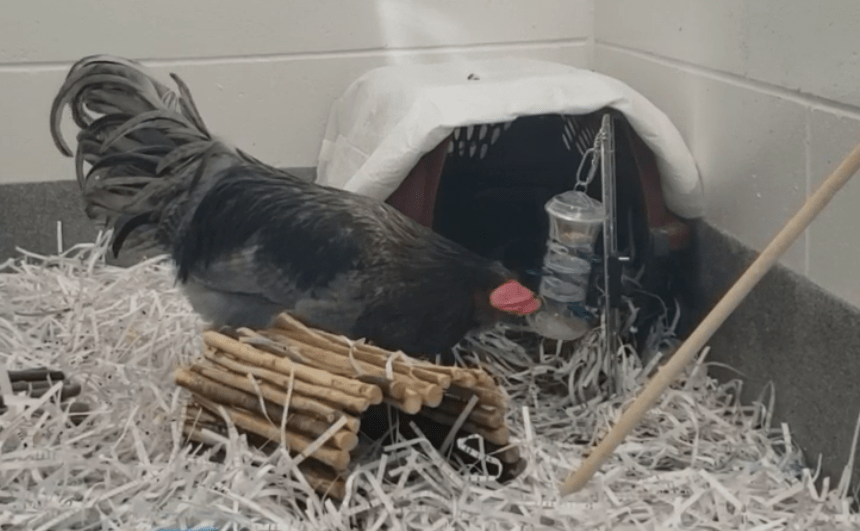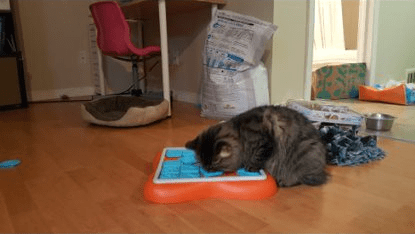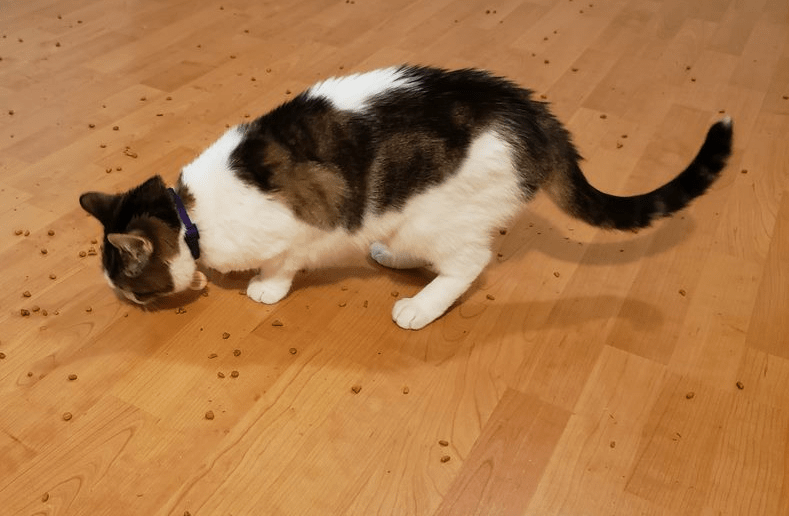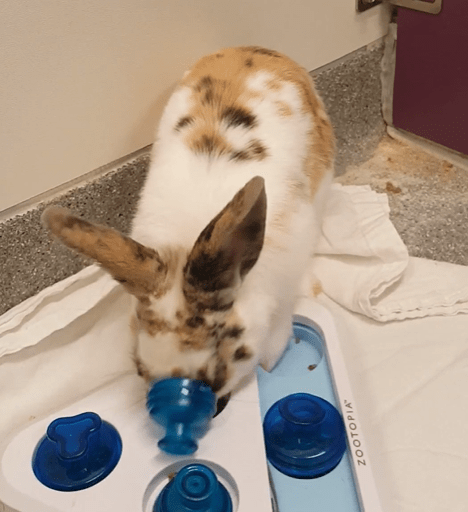Does your pet gobble down their food and beg for more? Do they wake you up early every morning wanting breakfast? Are they displaying other destructive or disruptive behaviours? Changing how you feed can help both you and your pet by slowing food consumption, encouraging them to use their brain to solve problems, and alleviating boredom.
What is feeding enrichment?
There are many different forms of feeding enrichment, but the underlying idea is to modify how food is presented to animals so that they need to forage or hunt for it. Many animal species have shown evidence of contra-freeloading, which means that they will choose to work for their food. It is also important to remember that even if an animal would not choose to work for their food, it doesn’t mean that it is not beneficial to their wellbeing. Providing enrichment can increase expression of normal species-specific behaviours, decrease stress, and improve wellbeing.

What kind of feeding enrichment to use
The types of feeding enrichment possible vary based on species, individual preferences and your interest. Feeding enrichment doesn’t need to be expensive or time consuming, many types of enrichment involve homemade items or feeding games.
Commercial feeding enrichments
A common commercial feeding enrichment involves kongs, which can be stuffed with food and frozen to slow eating. Lick mats with wet food are also popular, especially for dogs as it encourages licking which can reduce stress. Snuffle mats are composed of pieces of fabric that create flaps or ruffled areas that require animals to sniff around and find hidden pieces of food. Balls with small holes can have food placed inside so that the ball needs to be rolled around and pieces of food eaten one at a time. Puzzle feeders have moving pieces that need to be manipulated and are available in increasing levels of complexity.

DIY feeding enrichments
Many of these items can be replicated as DIY projects, just remember that the materials may not be as durable as commercial products, so these should not be used for pets who tend to destroy or eat their toys, and pets should always be supervised with these toys. Toilet paper rolls are a useful DIY material for puzzle feeders, they can have holes cut in the sides and ends pushed in to create a DIY treat tube, cut into loops and reassembled into a ball, or glued end down onto a piece of cardboard to create small tunnels that cats can reach into to retrieve kibble. Egg cartons encourage cats to use their paws to fish out food and can be cut into pieces and hidden around the house. Even a crumpled-up piece of paper or a rolled-up towel can be used to hide food.

Feeding games
Games that involve you are also great feeding enrichment and can improve your relationship with your pet. Most training can be done with your pet’s regular food, which saves the extra exciting treats for training more difficult behaviours. Food can be hidden around the room, up on cat trees or behind furniture, creating a fun game of hide and seek for your pet. Pieces of food can also be tossed one at a time across a room or down a hall so that pets can run after it and catch it. This is particularly useful for cats, who are small enough to run around indoors, this may not be such a good idea if you have a Great Dane! This type of enrichment provides cats with the opportunity to perform multiple parts of their hunting behaviour, including stalking, chasing and catching.
How to introduce feeding enrichment
A common myth is that if an animal has not been fed using feeding enrichment before, they won’t be able to figure it out, or that they are too lazy to use puzzle feeders. It is important when introducing feeding enrichment to remember that you may need to adjust what you are using or how you present it, to help motivate your pet to engage with the item. Including a few tasty treats in the enrichment item can help motivate your pet to work for it. It is also important to make sure that your pet is still getting their full meal even if that means feeding the rest in a bowl.
-For a pet who has only ever been fed from a bowl, the first step is to teach them that food can be found elsewhere. This may seem like an unnecessary step, but some animals won’t try engaging with enrichment items until they understand this concept. One way to introduce this is to scatter pieces of food on the floor, starting near the bowl then moving it farther away and spreading it out each day as your pet understands what is expected. Scatter feeding alone can be an easy way to slow down your pet’s eating and provide some enrichment and can easily transition into tossing pieces of food to encourage more activity.

– When introducing movable toys such as treat balls, open the holes as wide as they can go and put some food around and under the ball so that the only way to get at it is by pushing the ball, causing it to roll and release more food.
– With puzzles that have moving parts that must be manipulated, start with the easiest possible setting, leave flaps open at first, then close them slightly. If using a snuffle mat, start by sprinkling pieces of food on top rather than tucking it deep into the folds.
Remember, feeding enrichment is for your pet’s benefit, take it as slow as they need to be stimulated and learning but not overly frustrated. Be creative and have fun!

Written by:
Emily Fowler, BScH, DVM 2024
Reviewed by:
Dr. Caitlin Grant, DVM, DVSc
- Riggio G, Mariti C, Boncompagni C, Corosaniti S, Giovanni MD, Ogi A, et al. Feeding Enrichment in a Captive Pack of European Wolves (Canis Lupus Lupus): Assessing the Effects on Welfare and on a Zoo’s Recreational, Educational and Conservational Role. Animals (Internet). 2019 June 8 (cited 2022 May 31);9(6): 331. Available from: https://www.ncbi.nlm.nih.gov/pmc/articles/PMC6617013/
- Shepherdson DJ, Carlstead K, Mellen JD, Seidensticker J. The Influence of Food Presentation on the Behavior of Small Cats in Confined Environments. Zoo Biol (Internet). 1993 (cited 2022 My 31);12(2): 203-216. Available from: https://onlinelibrary.wiley.com/doi/abs/10.1002/zoo.1430120206


